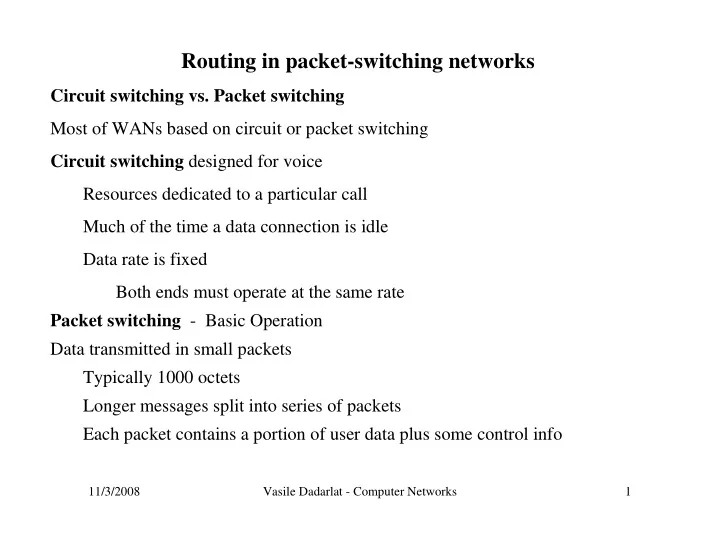

Routing in packet-switching networks Circuit switching vs. Packet switching Most of WANs based on circuit or packet switching Circuit switching designed for voice Resources dedicated to a particular call Much of the time a data connection is idle Data rate is fixed Both ends must operate at the same rate Packet switching - Basic Operation Data transmitted in small packets Typically 1000 octets Longer messages split into series of packets Each packet contains a portion of user data plus some control info 11/3/2008 Vasile Dadarlat - Computer Networks 1
Use of Control info Routing (addressing) info Packets are received, stored briefly (buffered) and past on to the next node Store and forward 11/3/2008 Vasile Dadarlat - Computer Networks 2
Advantages of packet switching Line efficiency Single node to node link can be shared by many packets over time Packets queued and transmitted as fast as possible Data rate conversion Each station connects to the local node at its own speed Nodes buffer data if required to equalize rates Packets are accepted even when network is busy Delivery may slow down Priorities can be used Packet Switching Technique Station breaks long message into packets Packets sent one at a time to the network Packets handled in two ways: Datagram or Virtual circuit 11/3/2008 Vasile Dadarlat - Computer Networks 3
Virtual Circuits v Datagram Virtual circuits Network can provide sequencing and error control Packets are forwarded more quickly No routing decisions to make Less reliable Loss of a node looses all circuits through that node Datagram No call setup phase Better if few packets More flexible Routing can be used to avoid congested parts of the network Use of variant with acknowledgements 11/3/2008 Vasile Dadarlat - Computer Networks 4
Comparison of datagrams & virtual-circuit subnets 11/3/2008 Vasile Dadarlat - Computer Networks 5
Routing Complex, crucial aspect of packet switched networks Characteristics required Correctness Simplicity Robustness Stability Fairness Optimality Efficiency 11/3/2008 Vasile Dadarlat - Computer Networks 6
Performance Criteria Used for selection of route Minimum hop Least cost algorithms (shortest path) Dijkstra’s Algorithm Implemented in link state packet routing algorithms Bellman-Ford algorithm Used by distance vector based 11/3/2008 Vasile Dadarlat - Computer Networks 7
Routing: Decision Time and Place Time On packet or virtual circuit basis Place Distributed routing Made by each node Centralized routing Source-based routing Network Information Source and Update Timing Routing decisions usually based on knowledge of network (not always) Distributed routing Nodes use local knowledge May collect info from adjacent nodes May collect info from all nodes on a potential route 11/3/2008 Vasile Dadarlat - Computer Networks 8
Central routing Collect info from all nodes Update timing When is network info held by nodes updated Fixed - never updated Adaptive - regular updates Routing Strategies Fixed Flooding Random Adaptive 11/3/2008 Vasile Dadarlat - Computer Networks 9
Fixed Routing Single permanent route for each source to destination pair Determine routes using a least cost algorithm Route fixed, at least until a change in network topology 11/3/2008 Vasile Dadarlat - Computer Networks 10
Flooding No network info required Packet sent by node to every neighbor Incoming packets retransmitted on every link except incoming link Eventually a number of copies will arrive at destination Each packet is uniquely numbered so duplicates can be discarded Nodes can remember packets already forwarded to keep network load in bounds Can include a hop count in packets 11/3/2008 Vasile Dadarlat - Computer Networks 11
Properties of Flooding All possible routes are tried Very robust At least one packet will have taken minimum hop count route Can be used to set up virtual circuit All nodes are visited Useful to distribute information (e.g. routing) Random Routing Node selects one outgoing path for retransmission of incoming packet Selection can be random or round robin Can select outgoing path based on probability calculation No network info needed Route is typically not least cost nor minimum hop 11/3/2008 Vasile Dadarlat - Computer Networks 12
Adaptive Routing Used by almost all packet switching networks Routing decisions change as conditions on the network change Failure Congestion Requires info about network Decisions more complex Tradeoff between quality of network info and overhead Advantages Improved performance Aid congestion control Complex system May not realize theoretical benefits 11/3/2008 Vasile Dadarlat - Computer Networks 13
Classification Based on information sources for network state Local (isolated) Route to outgoing link with shortest queue Can include bias for each destination Rarely used - do not make use of easily available info Adjacent nodes – select information based on the neighbour’s experience (network delays or outages) All nodes – used for source based routing 11/3/2008 Vasile Dadarlat - Computer Networks 14
Recommend
More recommend